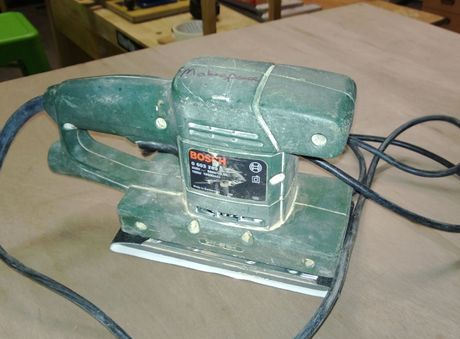Equipment/BoschSander
Equipment / Bosch Sander
Contents
Summary
The Orbital sander is probable the most common type of electric sander available. They are available with rectangular, square or round base plates. When using an orbital sander, there is no need to worry about the direction of wood grain.
These sanders can quickly cause fatigue and discomfort due to the vibration, High end models have superior vibration suppression to eliminate this problem but it can never be completely removed.
Owners
Health and Safety
Sharp Object/material
- Power supply to be disconnected when changing the sanding pad.
- Wait for the belt to stop moving before putting the tool down.
Slips, Trips and Falls
- Waste material/offcuts to be kept clear of work area.
Fire
- Equipment will be checked for defects before each use to minimise the risk of possible electrical faults or fire.
- Carbon Dioxide extinguisher to be available for any electrical fires
Electric shock
- The equipment will be checked before each use to ensure that there are no defects in the casing, battery or cutting head.
Sight/Noise/Dust/Vibration
- P.P.E. to be worn when using the equipment.
- Regular brakes to prevent fingers becoming numb
Repetitive Action/Physical Fatigue
- Regular breaks if work is lasting more than 5 minutes in duration
Training
Instructions
If you've never used a portable belt sander before, please watch these videos first Using an Orbital Sander (video)
Prepare your wood to be sanded by ensuring it is properly secured on the table or workbench.
Get the feel of the sander before you start your project. Hold it around or on top of the main housing with one hand. Alternating the hand position can keep your hand from getting too tired during long sanding jobs.
Place the pad lightly against the surface, firmly grasp the sander and then switch it on. Move the sander in long, overlapping movements, avoiding tipping it to the side or stopping in one spot.
Keep the sander moving at all times because leaving it one place may cause an uneven finish. Try not to remove too much wood at one time as this may cause excessive wear on your sander. It's made to remove material rapidly, but many people make the mistake of trying to remove too much too fast. Some woodworker's prefer to sand with the grain, but this isn't necessary with a random orbital sander.
Turn the sander off while you still have contact with the sanded surface and then lift it from your project. Make sure that the sanding pad has stopped rotating before you set it back down.
Tips & Tricks
Choose the correct grit of sandpaper for the job. They are available from course to fine.
Always keep the sander moving, as leaving it running in one place on the wood can prevent an uneven surface.
Don't tip the sander on its side, as the edge of the sander can cut into the wood
Hoover up the mess when your done!
Maintenance
Every month inspect for damage and general wear and tear and asses state of stock blades and replace as needed.
Every six months the carbon motor brushes should be inspected for wear, and replaced as necessary.
